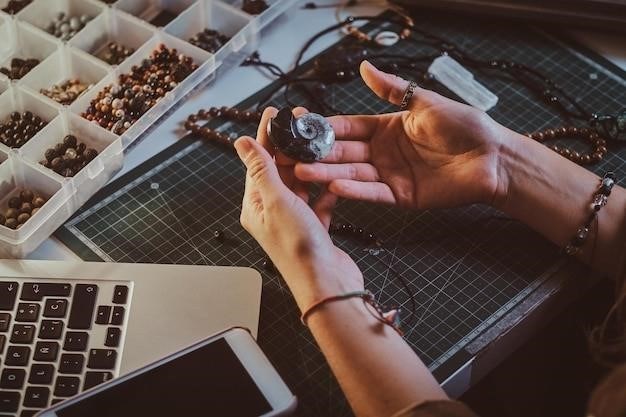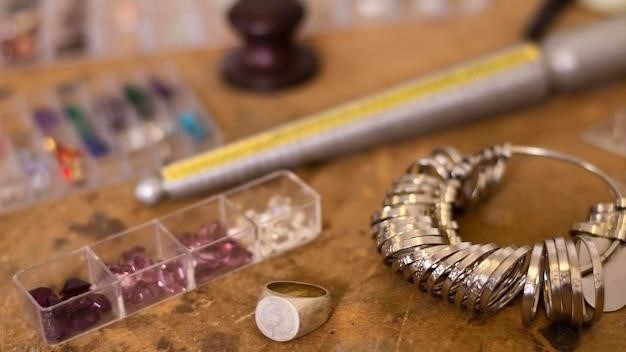Juliana Jewelry Identification and Value Guide
Juliana jewelry, crafted by DeLizza & Elster, is a highly sought-after collectible known for its vibrant colors, intricate designs, and unique construction. This guide provides insights into identifying, valuing, and appreciating Juliana jewelry, offering a comprehensive resource for collectors and enthusiasts alike.
What is Juliana Jewelry?
Juliana jewelry, a beloved vintage treasure, refers to the exquisite creations of DeLizza & Elster, a renowned American jewelry company that flourished from the 1950s to the 1980s. Their signature style, characterized by vibrant colors, intricate designs, and a unique construction technique, captivated the hearts of fashion enthusiasts and collectors alike. The term “Juliana” is a collector’s nickname, as the jewelry was initially marked only with paper or foil hang tags, which are often lost over time.
DeLizza & Elster’s jewelry is known for its bold and eye-catching aesthetics, featuring a wide array of materials, including glass, Lucite, Bakelite, and various metals. Their intricate designs often incorporated geometric patterns, floral motifs, and abstract elements, reflecting the artistic trends of the mid-century era. The company’s meticulous craftsmanship, coupled with its use of high-quality materials, has ensured that Juliana jewelry continues to hold its appeal and value decades later.
Identifying Juliana Jewelry
While Juliana jewelry wasn’t originally marked with a permanent identifier, several key features help collectors differentiate it from other vintage pieces. The most noticeable clue lies in the construction, particularly for bracelets. Authentic Juliana bracelets often feature a distinctive five-link and band construction, where the links are connected by a continuous band rather than individual clasps. This unique linking method is a hallmark of Juliana jewelry.
Another telltale sign is the use of glued-on stones. While some Juliana pieces might have prong-set stones, a majority utilize glue to secure their embellishments. This technique, though less common in contemporary jewelry, was a hallmark of Juliana’s production methods. Additionally, the back of Juliana pieces often reveals clues. Look for a smooth, flat back with minimal markings, as opposed to pieces with intricate engravings or hallmarks. While these features are helpful, they are not foolproof. A thorough examination is recommended, and consulting with experts or reputable online resources can provide further confirmation.
Key Features of Juliana Jewelry
Juliana jewelry is renowned for its distinctive characteristics that set it apart from other vintage pieces. Its vibrant color palette, encompassing a wide array of hues, is a defining feature. The use of bold, eye-catching colors, often in combination with intricate designs, contributes to the distinctive aesthetic of Juliana jewelry. Furthermore, the intricate designs and patterns employed in Juliana jewelry are another key characteristic. From geometric motifs to floral arrangements, the designs are often elaborate and visually appealing. The craftsmanship, though sometimes criticized for its use of glue, was nevertheless innovative for its time, enabling the creation of complex and intricate pieces.
The use of a variety of materials, including glass, plastic, and metal, is another defining feature of Juliana jewelry. While glass was a prevalent material, plastic and metal were also incorporated, allowing for a diverse range of styles and finishes. The combination of these materials contributed to the unique and often whimsical appeal of Juliana jewelry. Finally, the overall quality of Juliana jewelry, while not always considered high-end, is notable for its durability and resilience. Many pieces have survived the test of time, remaining in excellent condition despite their vintage status. These key features, combined with the company’s innovative approach to jewelry design, have contributed to the enduring popularity of Juliana jewelry among collectors and enthusiasts.
Juliana Jewelry Reference Books
For serious Juliana jewelry collectors, reference books are indispensable tools for identification, valuation, and understanding the history of these coveted pieces. One of the most sought-after references is “Juliana Jewelry Reference, DeLizza & Elster⁚ Identification & Price Guide” by Mitchell Pitman and Ann M. Pitman. This comprehensive guide, published in 2009, offers detailed information on identifying Juliana jewelry, including a searchable database of designs and a price guide for various pieces. The book is widely considered a standard resource for collectors and dealers, providing a wealth of knowledge about the history, styles, and value of Juliana jewelry.
Another valuable reference book is “Delizza & Elster Identification and Value Guide” by Ann M. Pitman, which is available through online platforms like Etsy. This book, reprinted in 2024, features detailed descriptions of Juliana jewelry styles, materials, and construction techniques. It also includes a comprehensive price guide, providing insights into the current market value of various pieces. These reference books, along with other resources, offer invaluable information for anyone interested in collecting and appreciating Juliana jewelry.
Online Resources for Juliana Jewelry Identification
The digital age has brought a wealth of online resources for Juliana jewelry enthusiasts, offering a convenient and accessible way to identify, research, and connect with other collectors. A valuable online resource is the website “isitjulianajewelry.com,” created by Wacker and Knutson. This website provides a searchable database of Juliana jewelry designs, allowing users to identify pieces based on specific features, such as jewelry type, color, stone type, and more. The database is a valuable tool for confirming authenticity, researching historical details, and connecting with other collectors.
In addition to dedicated websites, online forums and social media groups offer valuable platforms for sharing information, asking questions, and connecting with other Juliana jewelry enthusiasts. These online communities provide a space for collectors to share their finds, discuss identification challenges, and learn from experienced collectors. Furthermore, online auction platforms like eBay and Etsy provide opportunities to browse a vast collection of Juliana jewelry, allowing collectors to compare prices, research styles, and discover rare and unique pieces.
Juliana Jewelry Value Guide
Determining the value of Juliana jewelry is a multifaceted process that considers several factors, including condition, rarity, design, and market demand. The condition of a piece is paramount, with well-preserved pieces in excellent condition commanding higher prices. Rarity plays a significant role, with limited-edition designs or pieces from specific collections often fetching premium prices. The design and craftsmanship of Juliana jewelry are also crucial factors. Intricate designs, unique materials, and skilled execution contribute to a piece’s desirability and value.
Market demand is another key factor influencing the value of Juliana jewelry. Popular styles, colors, and themes tend to be in higher demand, driving up their prices. Collectors’ preferences and the overall market trends also play a role in determining value. While general guidelines exist, it is essential to consult with experienced Juliana jewelry appraisers or dealers for accurate valuations. They can provide expert assessments based on their knowledge of the market, specific pieces, and historical context.

Juliana Jewelry Styles and Collections
Juliana jewelry is renowned for its diverse array of styles and collections, reflecting the evolving tastes and trends of the mid-20th century. From bold and geometric designs to delicate and feminine pieces, Juliana offered a wide spectrum of choices to suit various preferences. Some of the most popular styles include⁚
- Five-Link Bracelets⁚ This signature design, featuring five interconnected links, is a hallmark of Juliana jewelry and remains highly sought after by collectors. The five-link construction creates a flexible and comfortable fit, making it a versatile piece for everyday wear.
- Dangling Beads⁚ Juliana jewelry often incorporated dangling beads or elements, adding a touch of movement and visual interest. These dangling features could range from simple beads to more elaborate charms and pendants, enhancing the overall aesthetic appeal.
- Color Themes⁚ Juliana pieces were known for their vibrant and bold use of color. Collections often featured specific color themes, such as turquoise, coral, or emerald green, allowing collectors to assemble matching sets or explore individual pieces that complement their personal style.
Beyond individual styles, Juliana also introduced limited-edition collections, often inspired by specific themes or events. These collections, often featuring unique designs and materials, are highly sought after by collectors for their rarity and historical significance.
Caring for Juliana Jewelry
Proper care is essential to preserve the beauty and value of Juliana jewelry. While vintage pieces may show signs of age, with careful handling and maintenance, you can ensure their longevity and continued enjoyment. Here are some key tips for caring for your Juliana treasures⁚
- Cleaning⁚ Juliana jewelry can be gently cleaned with a soft cloth and mild soap. Avoid harsh chemicals or abrasive cleaners that could damage the delicate metal or stones. For pieces with glued-on stones, use a soft brush and avoid soaking them in water.
- Storage⁚ Store Juliana jewelry separately to prevent scratching or tarnishing. Use individual boxes or pouches lined with soft fabric. Avoid storing jewelry in direct sunlight or humid environments, as this can accelerate wear and tear.
- Repairs⁚ If your Juliana jewelry requires repair, seek out a reputable jeweler specializing in vintage pieces. They can assess the damage and perform repairs using appropriate techniques to maintain the integrity of the original design.
By following these simple care guidelines, you can help ensure that your Juliana jewelry remains a cherished heirloom for generations to come. Remember, each piece tells a story, and with proper care, its beauty and value can be passed on to future generations.

Juliana Jewelry⁚ A Collector’s Guide
Collecting Juliana jewelry is a rewarding journey that combines a love for vintage fashion with the thrill of the hunt. Whether you’re a seasoned collector or just starting out, there are several aspects to consider to build a successful collection⁚
- Research⁚ Dive into the history of DeLizza & Elster, exploring their various styles, collections, and production periods. Familiarize yourself with the hallmarks and identifying features of Juliana jewelry.
- Authenticity⁚ Be cautious of fakes and reproductions. Use reputable resources and consult with experienced collectors to ensure you’re acquiring genuine Juliana pieces.
- Condition⁚ The condition of Juliana jewelry significantly impacts its value. Look for pieces that are well-maintained, with minimal wear and tear.
- Rarity⁚ Specific Juliana styles and collections are more rare than others. Research the market and identify pieces that are in high demand among collectors.
- Personal Taste⁚ Ultimately, collect what you love! Don’t be afraid to pursue pieces that resonate with your personal style and aesthetic.
Collecting Juliana jewelry is a journey of discovery and appreciation. With passion, knowledge, and careful selection, you can build a collection that reflects your unique taste and brings joy for years to come.
The Legacy of Juliana Jewelry
Juliana jewelry continues to hold a special place in the hearts of collectors and fashion enthusiasts. Its enduring appeal lies in its unique blend of affordability, accessibility, and timeless style. The vibrant colors, intricate designs, and playful spirit of Juliana pieces evoke a sense of nostalgia and capture the essence of a bygone era.
Beyond its aesthetic qualities, Juliana jewelry represents a significant chapter in the history of costume jewelry. DeLizza & Elster’s innovative techniques and commitment to quality established a high standard for the industry. Their pieces were not merely accessories, but expressions of personal style and a reflection of the cultural trends of the time.
Today, Juliana jewelry continues to be sought after by collectors, vintage fashion enthusiasts, and those who appreciate the enduring beauty and craftsmanship of a bygone era. Its legacy lives on, inspiring designers and reminding us of the power of jewelry to enhance our lives and reflect our individuality.

Leave a Reply